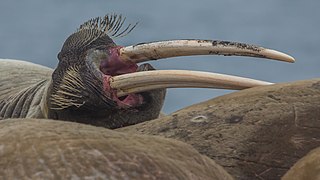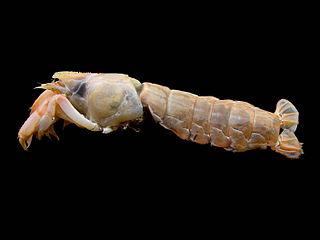
Bioturbation is defined as the reworking of soils and sediments by animals or plants. It includes burrowing, ingestion, and defecation of sediment grains. Bioturbating activities have a profound effect on the environment and are thought to be a primary driver of biodiversity. The formal study of bioturbation began in the 1800s by Charles Darwin experimenting in his garden. The disruption of aquatic sediments and terrestrial soils through bioturbating activities provides significant ecosystem services. These include the alteration of nutrients in aquatic sediment and overlying water, shelter to other species in the form of burrows in terrestrial and water ecosystems, and soil production on land.

Thalassinidea is a former infraorder of decapod crustaceans that live in burrows in muddy bottoms of the world's oceans. In Australian English, the littoral thalassinidean Trypaea australiensis is referred to as the yabby, frequently used as bait for estuarine fishing; elsewhere, however, they are poorly known, and as such have few vernacular names, "mud lobster" and "ghost shrimp" counting among them. The burrows made by thalassinideans are frequently preserved, and the fossil record of thalassinideans reaches back to the late Jurassic.

Axiidea is an infraorder of decapod crustaceans. They are colloquially known as mud shrimp, ghost shrimp, or burrowing shrimp; however, these decapods are only distantly related to true shrimp. Axiidea and Gebiidea are divergent infraoders of the former infraorder Thalassinidea. These infraorders have converged ecologically and morphologically as burrowing forms. Based on molecular evidence as of 2009, it is now widely believed that these two infraorders represent two distinct lineages separate from one another. Since this is a recent change, much of the literature and research surrounding these infraorders still refers to the Axiidea and Gebiidea in combination as "thalassinidean" for the sake of clarity and reference. This division based on molecular evidence is consistent with the groupings proposed by Robert Gurney in 1938 based on larval developmental stages.

Trypaea australiensis, known as the (marine) yabby or ghost nipper in Australia, or as the one-arm bandit due to their occasional abnormally large arm, and as the Australian ghost shrimp elsewhere, is a common species of mud shrimp in south-eastern Australia, and may be the only extant species in the genus Trypaea. T. australiensis is a popular bait used live or frozen by Australians targeting a range of species. It grows to a length of 6 centimetres (2.4 in) and lives in burrows in mudflats or sandbanks, especially in or near estuaries.

Callianassidae is a family of ghost shrimp crustaceans belonging to the infraorder Axiidea, within the order Decapoda.
Callianassa is a genus of mud shrimps, in the family Callianassidae. Three of the species in this genus have been split off into a new genus, Pestarella, while others such as Callianassa filholi have been moved to Biffarius. The genus is named after the Nereid of the Greco-Roman mythology.

Filhollianassa filholi is a ghost shrimp of the family Callianassidae, endemic to New Zealand, which grows up to 60 mm (2.4 in) long. It was known as Biffarius filholi until a 2019 taxonomic revision of the group.

Gilvossius tyrrhenus is a species of mud shrimp which grows to a length of 70 mm (2.8 in). It lives in burrows in shallow sandy parts of the sea-bed in the Mediterranean Sea and northern Atlantic Ocean. It is the most common thalassinidean in the Mediterranean, and has been used as bait by fishermen for at least 200 years.
Vulcanocalliax arutyunovi is a species of Thalassinidea found on a mud volcano in the Gulf of Cádiz between Spain and Morocco. It was discovered during the Census of Marine Life, and is so distinct from its closest relatives that it has been placed in a new subfamily, the Vulcanocallianacinae. The species is unusually large for a ghost shrimp, but despite that appears to brood only a single embryo. The species is named after the volcano on which it was discovered, Captain Arutyunov.

Clausidium is a genus of copepods that have been found in subtopical to temperate coastal areas along the Pacific, Atlantic and Gulf coasts of North America, the Pacific and Atlantic Coasts of South America, the Atlantic and Mediterranean coasts of Europe, the Atlantic coast of Africa, and the coast of India.

Neotrypaea californiensis, the Bay ghost shrimp, is a species of ghost shrimp that lives on the Pacific coast of North America. It is a pale animal which grows to a length of 11.5 cm (4.5 in). One claw is bigger than the other, especially in males, and the enlarged claw is thought to have a function in mating. N. californiensis is a deposit feeder that lives in extensive burrow systems, and is responsible for high rates of bioturbation. It adversely affects oyster farms, and its numbers are controlled in some places by the application of pesticides. It carries out an important role in the ecosystem, and is used by fishermen as bait.

Neotrypaea is a genus of ghost shrimp in the family Callianassidae, containing the following sixteen species:
Biffarius is a genus of ghost shrimp in the family Callianassidae, containing species formerly included in the genus Callianassa. Its members are small and generally live in the intertidal zone. In April 2020, a new species was described from the northeastern Brazilian coast. Biffarius was named in honour of Thomas A. Biffar, and includes the following species:

Lepidophthalmus turneranus, the Cameroon ghost shrimp, is a species of "ghost shrimp" or "mud lobster" that lives off the coast of West Africa. It occasionally erupts into dense swarms, one of which resulted in the naming of the country Cameroon.
Ctenocheloides is a genus of ghost shrimp in the family Ctenochelidae. Its first species, C. attenboroughi, was described in 2010 and named in honour of the British natural history broadcaster Sir David Attenborough.

Kraussillichirus kraussi, commonly named the common sandprawn or pink prawn, is a species of ghost shrimp, an African crustacean in the family Callichiridae.

Clausidium dissimile is a species of copepod that has been found along the Atlantic and Gulf Coasts from Massachusetts to Florida. They are found on the bodies of mud shrimp of the family Callianassidae, or from water collected from mud shrimp burrows.

Feeder shrimp, ghost shrimp, glass shrimp, grass shrimp, river shrimp or feeder prawns are generic names applied to inexpensive small, typically with a length of 1 to 3 cm, semi-transparent crustaceans commonly sold and fed as live prey to larger more aggressive fishes kept in aquariums.

Callichirus major sensu lato is a monophyletic species complex of ghost shrimp in the infraorder Axiidea, found in flat sandy beaches across the Pan-American coastline.
Paratya australiensis, the Australian glass shrimp or freshwater shrimp is a small decapod crustacean widely distributed in freshwater systems in south eastern Australia.












